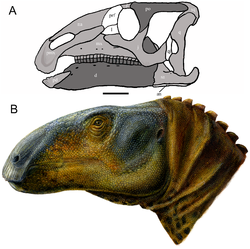Eohadrosaurus
|
Eolambia Temporal range: Late Cretaceous, 98.5 Ma |
|
|---|---|
 |
|
| A: Skull reconstruction. B: Life restoration. | |
| Scientific classification | |
| Kingdom: | Animalia |
| Phylum: | Chordata |
| Class: | Reptilia |
| Clade: | Dinosauria |
| Order: | †Ornithischia |
| Suborder: | †Ornithopoda |
| Clade: | †Hadrosauriformes |
| Superfamily: | †Hadrosauroidea |
| Genus: | †Eolambia |
| Type species | |
|
†Eolambia caroljonesa Kirkland, 1998 |
|
Eolambia is a genus of herbivorous iguanodontian dinosaur from the early Late Cretaceous Epoch of the USA.
In 1992 Carole Jones and her husband Ramal Jones near Castle Dale in Emery County, Utah, on the San Rafael Swell Anticline discovered a fossil site which would be named the Carol Quarry (sic) in her honour. Among the fossils were the remains of a euornithopod reported upon by James Ian Kirkland in 1994. Based on these fossils the type species Eolambia caroljonesa was named by Kirkland in 1998. The generic name comes from the Greek eos/ἠώς meaning 'dawn' or 'morning', implying 'early'. The Lambia suffix is after Lawrence Lambe, Canadian palaeontologist, whose name was given to Lambeosaurus. In all, the genus name means "dawn (or early) lambeosaurine". The specific name honours Carole Jones. The genus and species were also known informally before publication as "Eohadrosaurus caroljonesi"; the final name was suggested by Michael Skrepnick.
The holotype specimen, CEUM 9758, was found in the Mussentuchit Member of the Cedar Mountain Formation, probably dating to the Cenomanian, about 98.5 million year ago, though earlier estimates gave the age as the late Albian. It consists of a partial skull. Partial skeletons of adult and juvenile exemplars have been recovered together with eggs and embryos. The paratypes are CEUM 5212, CEUM 27749 and CEUM 24389. Referred specimens include OMNH 28919, OMNH 28511, OMNH 27749 and OMNH 04202. The finds represent at least eleven individuals and most elements of the skeleton.
...
Wikipedia
